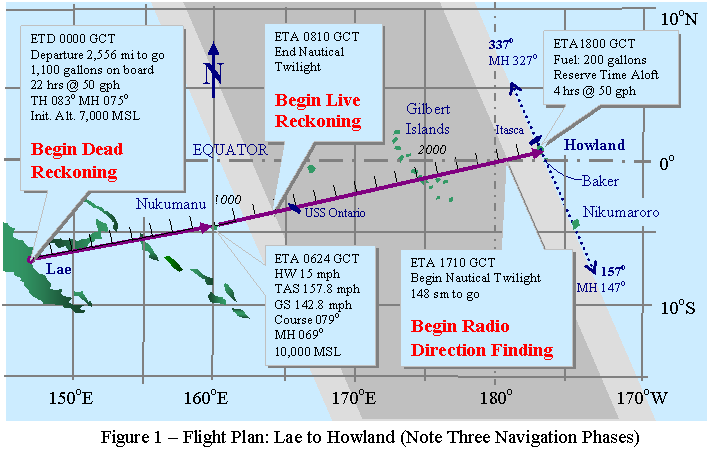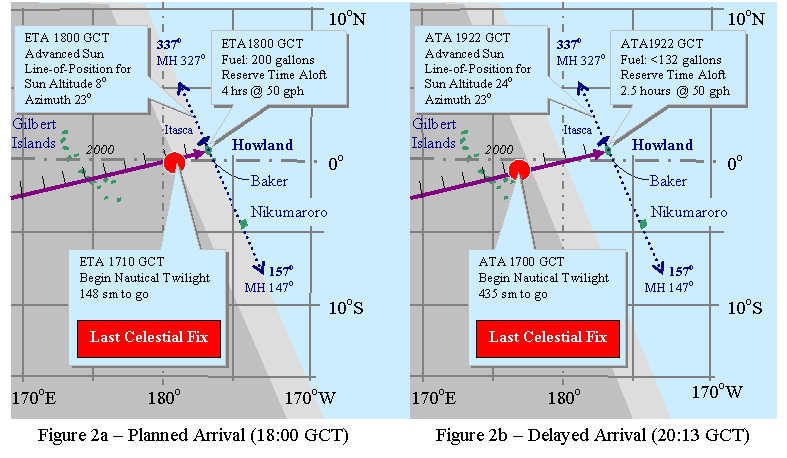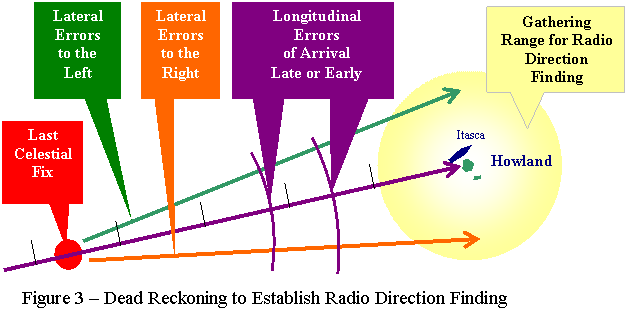| The
expression 'dead reckoning' is commonly
regarded by airplane pilots as an unclever
contraction of 'deductive reckoning',
preferring instead to use the term
'pilotage'.
That
etymology is not documented in any
historical dictionary. According to the Oxford
English Dictionary, 'dead reckoning'
dates from Elizabethan times
(1605-1615). In antiquity,
dead reckoning was navigation without
celestial references.
When
one uses stellar observations, one is, in
some sense, live -- working with
the stars and the movement of
planets. When one uses mere
compasses and clocks -- not objects in the
sky -- one is working dead.
|
 It
would be difficult to name a more qualified navigator
for Amelia Earhart's round-the-world adventure than
Frederick Joseph "Fred" Noonan, 44, an American sea
captain and aviation pioneer who charted the first
commercial airline routes across the Pacific Ocean
during the 1930s. Figure 1 below is based on
contemporaneous information and depicts Noonan's plan
for the ill-fated flight on July 2, 1937. It
would be difficult to name a more qualified navigator
for Amelia Earhart's round-the-world adventure than
Frederick Joseph "Fred" Noonan, 44, an American sea
captain and aviation pioneer who charted the first
commercial airline routes across the Pacific Ocean
during the 1930s. Figure 1 below is based on
contemporaneous information and depicts Noonan's plan
for the ill-fated flight on July 2, 1937.
Taking off from Lae in
New Guinea, Earhart and Noonan were to fly non-stop
to Howland
Island, a mere 450-acre speck, 2,556 statute
miles away, over vast stretches of equatorial
waters. Notations in the sketch provide key
parameters from the flight plan.
In retrospect, we recognize three
navigational phases:
Phase 1 Dead Reckoning in
daylight eastbound from Lae using island
checkpoints for 900 miles, making a slight
heading change overhead the island of
Nukumanu.
Phase 2 Live Reckoning (celestial
navigating) following nautical twilight,
flying in total darkness until reaching
nautical twilight -- dawn -- 148 miles
from Howland.
Phase 3 Radio Direction Finding
homing on signals broadcast by USCG Itasca,
loitering hard by Howland Island to support
the Electra's arrival. |
|
 Things did not quite work out as
planned. The flight was already being slowed in Phase
1 by higher than expected headwinds.
Indeed, shortly after the flight left Lae, weather
balloons launched in Hawaii were calling for changes in
the winds aloft forecast from 15 mph to 26.5 mph.
That update was not acknowledged by Amelia Earhart, but
about seven hours into the flight, she gave a position
report as follows:
Things did not quite work out as
planned. The flight was already being slowed in Phase
1 by higher than expected headwinds.
Indeed, shortly after the flight left Lae, weather
balloons launched in Hawaii were calling for changes in
the winds aloft forecast from 15 mph to 26.5 mph.
That update was not acknowledged by Amelia Earhart, but
about seven hours into the flight, she gave a position
report as follows:
"0718
GCT 4.33 SOUTH, 159.7 EAST, EIGHT THOUSAND,
CUMULUS,
WIND SPEED
23 KNOTS"
That report curiously agreed exactly with
the revised forecast by radiosonde
(23 kts = 26.5 mph). Earhart and Noonan were
'making good' only 130.3 mph instead of the planned
142.8 mph. The Electra's groundspeed
implied a total of more than 19.5 hours to reach Howland
Island.
 For a
long flight, fuel exhaustion would ordinarily be the
main concern; however, the Electra took off with 22
hours of fuel on board for an 18-hour
flight. Solvers of Here Comes the Sun puzzle
have addressed a different deadline: Noonan's
main concern was the time available for taking his Last Celestial Fix before
'nautical twilight'. For a
long flight, fuel exhaustion would ordinarily be the
main concern; however, the Electra took off with 22
hours of fuel on board for an 18-hour
flight. Solvers of Here Comes the Sun puzzle
have addressed a different deadline: Noonan's
main concern was the time available for taking his Last Celestial Fix before
'nautical twilight'.
Dawn would mark the end of Phase
2 at some distance away from Howland,
which inexorably increased with flight
delay.
Figure 2a below depicts the estimated
arrival situation for the planned
flight. Figure 2b shows the actual
situation, as Fred Noonan was forced to complete his Last Celestial Fix more
than 435 miles away from Howland Island--
hundreds of miles too far from Itasca for homing.
Cut
off from Live Reckoning
by the rising sun, he had no choice but to rely again
on compass and clock. More dead reckoning,
folks.

Dead reckoning is notorious for
accumulating navigation errors, dominated by imprecision
in steering and unknowable variations in wind intensity
and direction. Radio Direction Finding (RDF) has a
vital feature: correcting out navigation errors -- hey,
a terrestrial form of Live
Reckoning. Thus, all trans-oceanic
airline flights, which were already in service
throughout the '30s, routinely relied on homing for
reaching destinations. An out-of-commission beacon
at a destination aerodrome meant flying to an
alternative destination, period. As recognized by
solvers of the Point of No
Return puzzle, such an alternative was not
available for Amelia Earhart and Fred Noonan on that
fateful day in 1937.
 Figure
3 below depicts a gathering
range for RDF as a circle reaching out a hundred
miles or so in all directions from Itasca at
Howland Island. That estimate may not be
especially conservative, given the limitations in
wireless technologies back in the '30s. A
handful of available frequencies were crowded with
maritime broadcasts. Low power transmitters,
confusing protocols, some in Morse code others by
'radiophone' -- all these realities resulted in
uncoordinated transmissions and blocked signals for
the Earhart
Flight. Accordingly, as the sun began lighting
up the sky obliterating celestial objects, Fred Noonan
necessarily commenced a second interval of
dead reckoning. Over a distance 300 miles or more from
the Last Celestial Fix,
there would be nothing to do but hold a magnetic
heading in the windy sky and wait for an assigned
time-slot on a negotiated frequency, trying repeatedly
to establish RDF with Itasca -- the beginning
of Phase 3. Figure
3 below depicts a gathering
range for RDF as a circle reaching out a hundred
miles or so in all directions from Itasca at
Howland Island. That estimate may not be
especially conservative, given the limitations in
wireless technologies back in the '30s. A
handful of available frequencies were crowded with
maritime broadcasts. Low power transmitters,
confusing protocols, some in Morse code others by
'radiophone' -- all these realities resulted in
uncoordinated transmissions and blocked signals for
the Earhart
Flight. Accordingly, as the sun began lighting
up the sky obliterating celestial objects, Fred Noonan
necessarily commenced a second interval of
dead reckoning. Over a distance 300 miles or more from
the Last Celestial Fix,
there would be nothing to do but hold a magnetic
heading in the windy sky and wait for an assigned
time-slot on a negotiated frequency, trying repeatedly
to establish RDF with Itasca -- the beginning
of Phase 3.

For RDF to be successful, equipment and
people on the ground and on board the aircraft must work
properly. Solvers of the Simplexity Aloft puzzle
have studied the two RDF modes, Simplex
and Half-Duplex.
One day before the flight,
Amelia Earhart took the Electra aloft for a brief test
of the engines and instruments, which included
exercising the on-board RDF equipment. Using the
Electra's loop antenna, she was unable to
obtain a relative bearing from a ground station at
Lae. She speculated that the signal was simply
too strong for a "null."
Her speculation was apparently wrong,
for we shall see in Which way,
Amelia? that the on-board
RDF equipment must have been defective and Simplex RDF was not available for
completing the flight.
 Figure 1 above shows the USS Ontario
1,200 miles into the flight, about half-way to
Howland. The U.S. Navy made the ocean-going
tug available as an RDF fix in Phase 2.
If either mode of RDF succeeded, however, no
evidence is recorded in the form of a position
report by Amelia Earhart. Moreover,
according to the ship's logs, two-way communications
were never established with the Electra, which ruled
out Half-Duplex RDF at Ontario and
thereby put in doubt any expectations for Simplex
RDF using a radio transmitter on Itasca as a homing
beacon. Figure 1 above shows the USS Ontario
1,200 miles into the flight, about half-way to
Howland. The U.S. Navy made the ocean-going
tug available as an RDF fix in Phase 2.
If either mode of RDF succeeded, however, no
evidence is recorded in the form of a position
report by Amelia Earhart. Moreover,
according to the ship's logs, two-way communications
were never established with the Electra, which ruled
out Half-Duplex RDF at Ontario and
thereby put in doubt any expectations for Simplex
RDF using a radio transmitter on Itasca as a homing
beacon.
With one
exception, there are no records throughout Amelia
Earhart's last flight that any radio
transmissions were received on board the
Electra. In effect, she made her transmissions 'in
the blind'. Here is that exception...
"KHAQQ
CALLING ITASCA WE RECEIVED YOUR SIGNALS BUT UNABLE
TO GET A MINIMUM PLEASE TAKE BEARING ON US AND
ANSWER 3105 WITH VOICE."
...which depicts an
admission by Amelia Earhart that Simplex RDF
had failed and that she was changing to Half-Duplex
RDF. Solvers of Which
Way Amelia? will have some idea about the
reasons why neither RDF mode could be made to
work. Given the failed two-way communications
with Ontario, Earhart and Noonan must have
concluded long before sunrise that Phase 3
was in serious jeopardy -- that for the approach to
Howland there would be no Live Reckoning -- no homing by
radio, that is (see Shoot the
Moon)..
|
What
would your advice have been for completing
the flight successfully?
|
GO TO SOLUTION
PAGE

|

 It
would be difficult to name a more qualified navigator
for Amelia Earhart's round-the-world adventure than
Frederick Joseph "Fred" Noonan, 44, an American sea
captain and aviation pioneer who charted the first
commercial airline routes across the Pacific Ocean
during the 1930s. Figure 1 below is based on
contemporaneous information and depicts Noonan's plan
for the ill-fated flight on July 2, 1937.
It
would be difficult to name a more qualified navigator
for Amelia Earhart's round-the-world adventure than
Frederick Joseph "Fred" Noonan, 44, an American sea
captain and aviation pioneer who charted the first
commercial airline routes across the Pacific Ocean
during the 1930s. Figure 1 below is based on
contemporaneous information and depicts Noonan's plan
for the ill-fated flight on July 2, 1937. 

